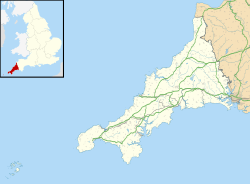This article needs additional citations for verification. (May 2014) |
RAF Dry Tree was a Royal Air Force early warning radar station for detecting enemy aircraft during the Second World War. It was built in 1940 on Goonhilly Downs, on the Lizard peninsula in Cornwall, a short distance to the south-east of the Goonhilly Earth Station.[1][2] It was named from the standing stone on the land known as the Dry Tree menhir.
| RAF Dry Tree | |
|---|---|
| Goonhilly Downs Near Helston, Cornwall in United Kingdom | |
 View inside the receiver block at RAF Dry Tree. | |
| Coordinates | 50°2′44.1″N 5°12′18.24″W / 50.045583°N 5.2050667°W |
| Type | Chain Home radar station |
| Height | four 360 feet (110 m) transmitter masts |
| Site information | |
| Owner | Air Ministry |
| Operator | Royal Air Force |
| Open to the public | yes |
| Site history | |
| Built | 1940 |
| In use | 1940- |
| Fate | demolished with the exception of ground level buildings and concrete hardstandings |
| Battles/wars | Second World War |
Purpose
editIts purpose was detecting aircraft approaching South Cornwall and the Western Approaches. It had four 360 feet (110 m) transmitter masts and two 240 ft (73 m) wooden receiver masts.[1] Its existence was only revealed after the war had ended. Most of the station was destroyed in the early 1960s to make way for the satellite communication station. Some buildings and structures still exist and are located within a nature reserve. The nerve centre was the receiver block which now has public access to the roof, giving excellent views across the Downs. Other buildings and structures which were part of RAF Dry Tree can also be seen.
Dry Tree menhir
editThe Dry Tree menhir is a ten foot standing stone located on the ex-RAF Dry Tree site at Goonhilly,[3] which the station takes its name from. The menhir was seemingly named Dry Tree due its resemblance to a dry tree trunk.
See also
editReferences
edit- ^ a b hydealfred. "RAF Dry Tree Chain Home Radar Station". Derelict Places. Retrieved 29 November 2014.
- ^ "Site of RAF Dry Tree". Geograph. Retrieved 31 May 2014.
- ^ "Dry Tree Menhir | HELSTON HISTORY". Retrieved 11 October 2021.
